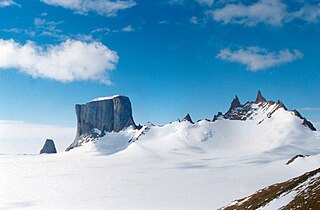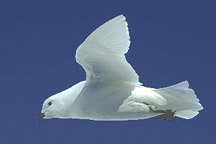Related Research Articles

Signy Island is a small subantarctic island in the South Orkney Islands of Antarctica. It was named by the Norwegian whaler Petter Sørlle (1884–1933) after his wife, Signy Therese.

Thurston Island is a largely ice-covered, glacially dissected island, 135 nautical miles long and 55 nautical miles wide, lying between between Amundsen Sea and Bellingshausen Sea a short way off the northwest end of Ellsworth Land, Antarctica. The island is separated from the mainland by Peacock Sound, which is occupied by the west portion of Abbot Ice Shelf.

The Prince Charles Mountains are a major group of mountains in Mac. Robertson Land in Antarctica, including the Athos Range, the Porthos Range, and the Aramis Range. The highest peak is Mount Menzies, with a height of 3,228 m (10,591 ft). Other prominent peaks are Mount Izabelle and Mount Stinear. These mountains, together with other scattered peaks, form an arc about 420 km (260 mi) long, extending from the vicinity of Mount Starlight in the north to Goodspeed Nunataks in the south.
The Sør Rondane Mountains are a group of mountains about 100 miles (160 km) long with main peaks rising to 3400 m, between the Queen Fabiola Mountains and Wohlthat Mountains in Queen Maud Land. They were discovered and photographed from the air by members of the Lars Christensen Expedition (LCE) on February 6, 1937, and named after Rondane, a mountain massif in southern Norway. The mountains and their constituent features were mapped in greater detail and named in 1957 by Norwegian cartographers working with air photos taken by U.S. Navy Operation Highjump, 1946–47.

Annenkov Island is an island in South Georgia and the South Sandwich Islands, to the west of the main island of South Georgia. The Pickersgill Islands are to its southeast. It is irregularly shaped and 4 miles (6.4 km) long and 650 m (2,130 ft) high, lying 8 miles (13 km) off the south-central coast of South Georgia.

Ising Glacier is a glacier flowing northwest between Isingen Mountain and Kvitkjolen Ridge in the Sverdrup Mountains of Queen Maud Land, Antarctica. It was photographed from the air by the Third German Antarctic Expedition (1938–39). It was mapped by Norwegian cartographers from surveys and air photos by the Norwegian–British–Swedish Antarctic Expedition (1949–1952), led by John Schjelderup Giæver, and from air photos by the Norwegian expedition (1958–59) and named Isingbreen.
Austvorren Ridge is the eastern of two rock ridges which trend northward from the Neumayer Cliffs in Queen Maud Land. It was photographed from the air by the Third German Antarctic Expedition (1938–39), and mapped by Norwegian cartographers from surveys by the Norwegian–British–Swedish Antarctic Expedition (1949–1952), led by John Schjelderup Giæver and from air photos by the Norwegian expedition (1958–59) and given the name "Austvorren".

The Mühlig-Hofmann Mountains is a major group of associated mountain features extending east to west for 100 km (62 mi) between the Gjelsvik Mountains and the Orvin Mountains in Queen Maud Land, East Antarctica. With its summit at 3,148 metres (10,328 ft), the massive Jøkulkyrkja Mountain forms the highest point in the Mühlig-Hofmann Mountains.

The Gruber Mountains are a small group of mountains consisting of a main massif and several rocky outliers, forming the northeast portion of the Wohlthat Mountains in Queen Maud Land, Antarctica. They were discovered and plotted from air photos by the Third German Antarctic Expedition (GerAE), 1938–39, under Alfred Ritscher. The mountains were remapped by the Sixth Norwegian Antarctic Expedition, 1956–60, who named them for Otto von Gruber, the German cartographer who compiled maps of this area from air photos taken by the GerAE. This feature is not to be confused with "Gruber-Berge," an unidentified toponym applied by the GerAE in northern the Mühlig-Hofmann Mountains.
Kvitkjølen Ridge is a rock ridge between ice filled Kvitsvodene Valley and Ising Glacier in the Sverdrup Mountains of Queen Maud Land, Antarctica. It was photographed from the air by the Third German Antarctic Expedition (1938–39). The ridge was mapped by Norwegian cartographers from surveys and air photos by the Norwegian–British–Swedish Antarctic Expedition (1949–52) and air photos by the Norwegian expedition (1958–59) and named Kvitkjølen.
Stuttfloget Cliff is a steep rock cliff forming the southwest end of Mount Grytoyr in the Muhlig-Hofmann Mountains, Queen Maud Land. Mapped by Norwegian cartographers from surveys and air photos by the Norwegian Antarctic Expedition (1956–60) and named Stuttfloget.
Mount Grytøyr is a broad ice-topped mountain, 2,695 metres (8,840 ft) high, between Flogeken Glacier and Stuttflog Glacier in the Mühlig-Hofmann Mountains of Queen Maud Land, Antarctica. It was mapped by Norwegian cartographers from surveys and air photos by the Sixth Norwegian Antarctic Expedition (1956–60) and named for B. Grytøyr, a meteorologist with the expedition (1956–58).

Flogeken Glacier is a deeply entrenched glacier, flowing northwest between Mount Grytoyr and Langfloget Cliff, in the Mühlig-Hofmann Mountains of Queen Maud Land, Antarctica. it was mapped by Norwegian cartographers from surveys and air photos by the Sixth Norwegian Antarctic Expedition (1956–60) and named Flogeken.
Midbresrabben Hill is an isolated rock hill protruding above the ice between Penck Trough and Jutulstraumen Glacier, east of the Borg Massif in Queen Maud Land, Antarctica. It was mapped by Norwegian cartographers from surveys and air photos by the Norwegian–British–Swedish Antarctic Expedition (1949–52) and from air photos by the Norwegian expedition (1958–59) and named "Midbresrabben".
Hamarskorvene Bluff is a rock and ice bluff just east of Kvithamaren Cliff in the Mühlig-Hofmann Mountains of Queen Maud Land, Antarctica. It was mapped and named by Norwegian cartographers from surveys and air photos by the Sixth Norwegian Antarctic Expedition (1956–60).

Hansenbreen is a glacier 15 nautical miles (28 km) long, flowing north along the west side of Mount Nils Larsen in the Sør Rondane Mountains of Antarctica. It was roughly mapped by Norwegian cartographers from air photos taken by the Lars Christensen Expedition, 1936–37, and remapped by them in greater detail in 1957 from air photos taken by U.S. Navy Operation Highjump, 1946–47. It was named for Hans Edvard Hansen, a Norwegian cartographer who compiled these and other maps for Norwegian Antarctic expeditions.

Mjell Glacier is a glacier 9 nautical miles (17 km) long, flowing northeast between Mount Bergersen and Isachsen Mountain in the Sør Rondane Mountains of Antarctica. It was mapped by Norwegian cartographers in 1957 from air photos taken by U.S. Navy Operation Highjump in 1946–47, and named "Mjellbreen".
Låghamaren Cliff is a rock cliff forming the northwest end of the Hamrane Heights in the Sverdrup Mountains of Queen Maud Land, Antarctica. It was photographed from the air by the Third German Antarctic Expedition (1938–39), and was mapped by Norwegian cartographers from surveys and air photos by the Norwegian–British–Swedish Antarctic Expedition (1949–52) and air photos by the Norwegian expedition (1958–59) and named Låghamaren.

Langflog Glacier is a glacier flowing north between Mount Hochlin and Langfloget Cliff in the Mühlig-Hofmann Mountains of Queen Maud Land, Antarctica. It was mapped by Norwegian cartographers from surveys and air photos by the Sixth Norwegian Antarctic Expedition (1956–60) and named Langflogbreen.
References
- ↑ "Langfloget Cliff". Geographic Names Information System . United States Geological Survey, United States Department of the Interior . Retrieved 2013-05-29.
![]() This article incorporates public domain material from "Langfloget Cliff". Geographic Names Information System . United States Geological Survey.
This article incorporates public domain material from "Langfloget Cliff". Geographic Names Information System . United States Geological Survey.